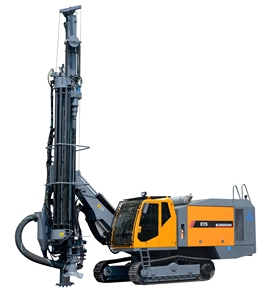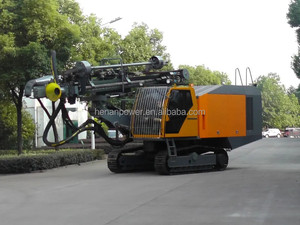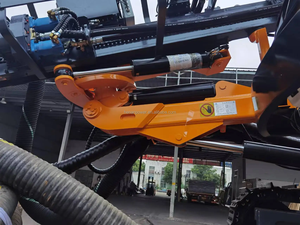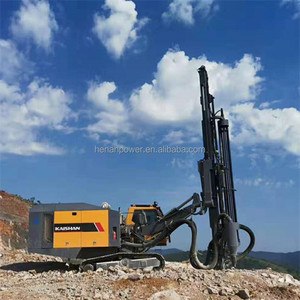
All categories
Featured selections
Trade Assurance
Buyer Central
Help Center
Get the app
Become a supplier

(3375 products available)










































Oil rig tools are a variety of mechanical devices used during drilling operations. They assist in managing and carrying the drilling pipe, ensuring that the bits are changed efficiently, and maintaining various controls and parameters related to the oil well's pressure and mechanical aspects.
Drilling Tools:
Drilling tools are the oil rig tools directly working on the geological formation to extract the targeted oil. They are specially engineered to tackle various geological conditions. Moreover, they play a key role in determining the rate of penetration and the quality of the extracted oil.
Function:
The primary function of drilling tools is to penetrate Earth’s layers to access oil deposits. Depending on the geology and required oil, different types of drilling tools are selected.
Common Types:
The drill bit directly cuts through rock layers and is the first component of the drilling tool assembly. The bits are changed with the help of drift pins, which are small metal rods inserted into the drilling equipment.
Another key drilling tool is the reamer, which enlarges existing holes to improve the quality of the drilled well. Finally, we have the drill collars and pipes that help manage the weight and torque of the drilling equipment.
Completion Tools
After the oil well has been drilled, completion tools are used to prepare the well for production. These tools help in placing devices that will allow the oil to flow freely.
Key Devices:
Production casing refers to the metallic tubing installed within the well to uphold the wellbore. It also ensures that oil can be extracted safely. Wellbore Cleanout Tools help remove any debris or obstruction within the wellbore before the actual production begins. Furthermore, Formation Testing Tools assist in evaluating the geological formation surrounding the well to determine the optimal method of oil extraction.
Maintaining Tools:
Oil rigs require constant maintenance to ensure safe operations. Maintenance tools are used to provide support to the oil extraction process.
Oil rigs use various wrench types to grip, turn, tighten, and loosen pipes and other equipment. Oil rigs also employ specialty wrenches to loosen pipes with existing lubricants.
Replacement parts are also used in oil rigs to provide additional support. Oil rigs often use API RP 7G-1 replacement parts, which are regulated and standardized for safety and efficiency.
Proper maintenance of oil well tools helps to boost the efficiency of operations while ensuring the safety of workers at the oil mining site. Below are some general maintenance tips for oil rig tools:
In addition to the above maintenance tips, it's useful to always follow the manufacturer guidelines for care and maintenance practices of specific oil rig tools. Doing this helps to ensure longevity and optimal performance of the equipment.
With the boom in shale oil and gas production around the world, oil rig tools used in drilling at onshore locations have seen increased demand. Drilling bits, used for the first stage of the drilling process when priming the well, are in high demand, especially NPR bits, which are used for drilling through hard rock layers such as granite.
According to the International Energy Agency (IEA), global oil demand is expected to rise in the coming years. This is expected to increase the requirement for oil rig tools, especially in offshore areas where oil rigs have been present for some time now. According to estimates, around 7 to 8 million barrels of oil per day are produced from offshore oil fields.
As global energy demands rise due to global population increase and economic development, the efficiency and productivity of existing oil rigs are being sought by energy firms all over the world. This need is expected to fuel the world's demand for oil rig equipment and tools, especially those with advanced technology that can make drilling more efficient.
It is not only the demand for oil drilling tools that has seen a rapid increase over the past few years, but also ancillary equipment used on oil rigs, such as safety and management system tools. This includes equipment to detect gas leaks to avoid fire or explosion hazards, as well as emergency shutoff systems to quickly stop the flow of oil and respond to emergencies. Further, logistical equipment such as cranes and pipes used to transport oil to refineries also require specialized tools and equipment that have to comply with safety regulations and equipment standards.
According to market reports, the global oil field equipment market size was valued at $88.5 billion in 2021 and is projected to reach $125.4 billion by 2030, registering a CAGR of 4.1% from 2022 to 2030. The demand for oil rig tools is expected to increase as the supply of crude oil is closely linked to production activities. This includes exploration, extraction, refining, and sale activities.
When choosing oil rig tools, a variety of things such as job requirements, tool quality, safety features, compatibility, and supply and demand are critical to take into account.
Q1, What are the key trends affecting oil rig tools?
A1 The global shift toward renewable energy is creating demand for oil rig tools that support efficient extraction and processing of fossil fuels. Advances in automation and digitalization are boosting demand for smart oil rig tools with AI-driven analytics and predictive maintenance capabilities. The growing focus on operational efficiency is increasing the adoption of multifunctional oil rig tools that can perform a wide range of tasks.
Q2, What are the biggest challenges in the oil rig tools market?
A2 The oil rig tools market faces challenges like supply chain disruptions, fluctuating raw material prices, and the high cost of advanced oil extraction technologies. The global uncertainty surrounding fossil fuel demand due to the energy transition is hampering investment in new oil rig tool developments. Finding qualified personnel with expertise in operating complex oil rig tools remains a major challenge for the industry.
Q3, What is the outlook for the oil rig tools market?
A3 Despite challenges posed by the energy transition, the oil rig tools market is set to grow on account of rising oil demand in emerging economies. Investment in infrastructure development projects in Asia-Pacific and Africa will boost the need for oil extraction. The market will also benefit from demand for upgraded and automated oil rig tools.
Q4, What types of oil rig tools do consumers purchase the most?
A4 Extraction tools like pipe wrenches, rig tongs, and casing running tools account for the largest share of units sold. These multifunctional tools are used for a wide range of tasks in oil rig extraction, which boosts their demand. However, there is rapid growth in specialized oil rig tools with advanced features.
Q5, How long do oil rig tools last?
A5 The lifespan of oil rig tools depends on factors like construction material, frequency of use, maintenance, exposure to harsh conditions, and operational efficiency. Basic oil rig hand tools can last for a decade or more with proper care. Specialized high-tech tools require regular maintenance and calibration to ensure optimal performance and can last for 5 to 10 years.